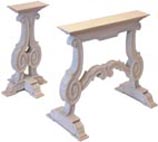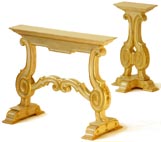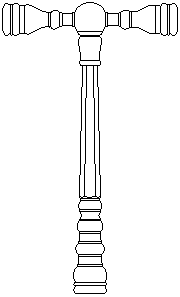The Design of a prototype Neapolitan harpsichord
The string scalings
The most fundamental aspect of the design of any harpsichord is that of the string scalings. In the case of the design of this harpsichord it was decided to make no compromises with this aspect of the scheme. The string scalings would have no bass foreshortening and would therefore be Pythagorean throughout the whole of the compass. The reason for doing this was to ensure that the sound was equally clear and that the notes had a good harmonic structure throughout the whole of the compass. This should, in turn ensure that there was a good balance in the sound through all registers of the compass.
With a basic bass scaling of c2 = 13 once = 283.9mm, this would mean that the length of the longest notes C would have to be 8x13 = 104 once = 2270.7mm. This is very long (the bottom note of a French harpsichord F1 a fourth lower is only about 1830mm in length) and would mean that the instrument itself would have to be very long. Red brass is normally used for the bass notes at a scaling of about 230mm (10˝ once = 229.3mm). Therefore the note C with a red brass scaling would have a length of 8x10˝ = 84 once = 1834.1mm. This although still very long is, however, a practicable length which does not make the total length of the instrument unreasonably great.
It was therefore decided to use a basic brass scaling of 13 once in the treble and bass with the lowest bass notes based on a red brass scaling of 10˝ once. A graph of these scalings is shown below.
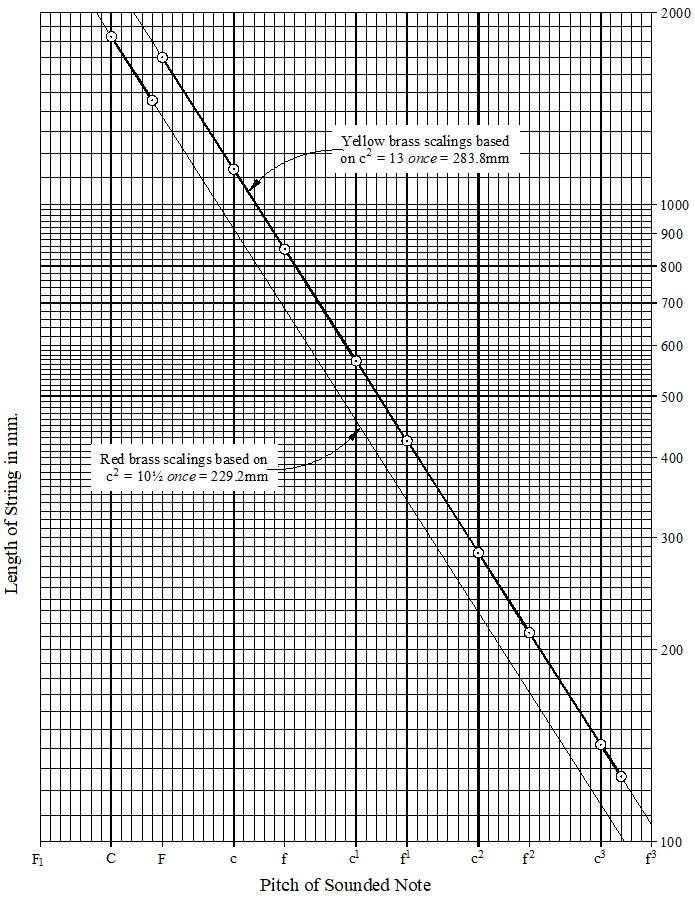
This graph shows clearly that the string lengths that are perfectly Pythagorean in nature so that they halve and double with each octave rise and fall in pitch from the top d3, right down to F, and then they are again Pythagorean but based on c2 = 10˝ once suitable for the red-brass strings although only for the notes from C to E.
The Pythagorean scalings give string lengths that are very long in the bass and produce a very long instrument. See the details of the plan view of this instrument with a further elaboration of the importance of using Pythagorean scalings throughout the whole compass of the instrument.
A stick was made and was used to measure out the string lengths, and another stick was made to give the lateral string spacing in order to measure out the string-scaling design on the baseboard and soundboard.
![]()
The design of the case and keyboard
The study of the Neapolitan harpsichords by Onofrio Guarracino showed them to be extremely simple and elegant in their design. It was therefore decided to draw an instrument using the same principles as had been used by Guarracino to give an instrument with a C to d3 compass similar to that of the Russell Collection anonymous Neapolitan harpsichord (Russell Collection Catalogue Number HS1-A1620.2). The string scaling design was based on the principles outlined above. After some months of careful design and drawing using AutoCAD, the following drawing was the result:

This design is for a separate instrument in an outer case (cassa levatoia). A second drawing, almost identical to this one was made for an integral instrument with no separation between the inner and outer instrument (cassa falsa levatoia). All of the measurements in these drawings are given in Neapolitan once (1 oncia = 21.835mm) and not in some modern unit of measurement.
The figure below shows a part of the drawing of the integral instrument (cassa falsa levatoia) with the measurements of a number of features in a schematic section near the tail all given in Neapolitan once. This diagram is for the instruments of the cassa falsa levatoia type; here because the 'false case' is a half an oncia thick the line of the bridge pins is 6 once from the 'virtual' bentside and 6.5 once from the actual bentside (see the placement of the bridge in Guarracino harpsichords). See the diagram below.
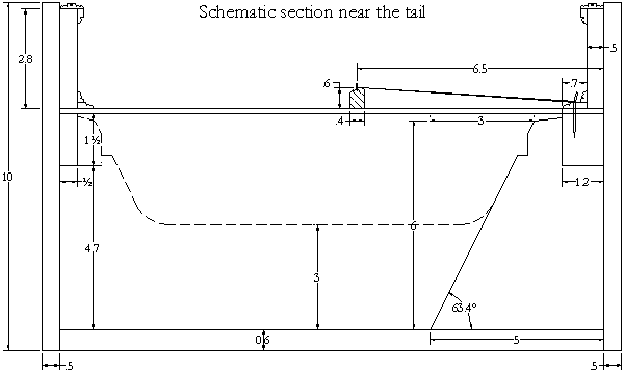
Another stick was made with marks giving the various case dimensions in order to mark these out on the baseboard of the instruments.
A resumé of the procedure used to build these harpsichords is given elsewhere on this site.
![]()
The design of the stop levers
In order to provide the maximum possible degree of flexibility in the registrational possibilities of this harpsichord it was decided to allow either or both registers to be inserted or dis-inserted. This meant further that, for the convenience of the harpsichordist, both registers should be equipped with register levers. The fact that two levers were required and that Partenope, the most potent icon of Naples and one of the dominant images of this project, had two tails, immediately suggested that the two stop levers should have the form of Partenope's tails.
It was therefore decided to cast two register levers in brass to use to move the registers. More details about these can be obtained by clicking on the image below:
![]()
The design of a Neapolitan-style stand
The Russell Collection anonymous Neapolitan harpsichord (see the photograph, including the stand, in Anonymous Neapolitan harpsichord in the Russell Collection) is one of the few Italian harpsichords to retain a stand that matches the decoration of the instrument under which it is placed and which is therefore probably original. It is therefore one of even fewer Neapolitan harpsichords to have retained its original stand. Stylistically this stand is very similar to the stand of the 1667 Onofrio Guarracino virginal in the Museo Teatrale alla Scala in Milan (Catalogue number MTS-TP/03) the decoration of which also matches the instrument. The main difference is that the Russell Collection Neapolitan stand has true carved relief whereas the Milan Guarracino virginal stand has only trompe l'oiel relief painted onto flat surfaces. However, because of the similarity in the style of the two stands, and the similarity of both of these to other Neapolitan furniture, it was decided to design a stand which was an amalgam of both and incorporated features from the two different stands. The resulting design is shown below with the front stand (with a side view of one of its ‘feet’) on the left and the rear stand shown in front and side views on the right.
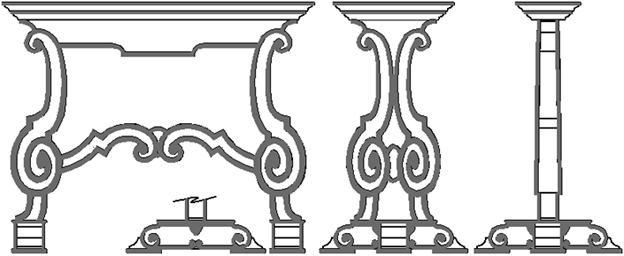
Several of these stands have now been completed. They are available as an additional option to the 'standard' turned stands. The latter are included in the price of the instrument whereas these elaborate stands are available at an additional cost.
Click on these images to see a more detailed photograph.
![]()
The design of a Neapolitan-style music desk
Using a photograph of another anonymous Neapolitan harpsichord in private ownership in Buenos Aires as a model, a new music desk modelled on the original has been designed for these Neapolitan harpsichords. A part of this design, also carried out using AutoCAD, is shown below:
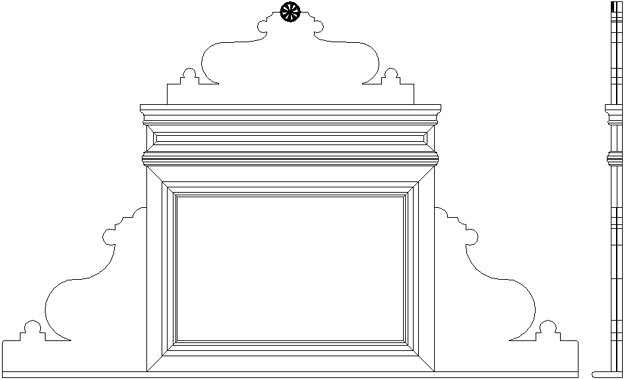
Three of these splendid music desk have now been built and will be available as a special option on the Neapolitan harpsichords under construction. The total height of this music desk is 10˝ once (228.5mm) high and it has a total width of 26 once (567.7mm) and so is big enough for even the largest of scores, photocopied scores, etc.
Click on this image to see an image of a finished music desk.
![]()
A simple version of the above music desk
A less extravagant version of the music desk above is also available. This design is shown below:

Three music desks to this simple design are being made up and will be available at a lower cost in place of the elaborate music desks illustrated above which involve much more work. This desk is 13 once (283.9mm) high by 14 once (305.7mm) wide.
Click on this image to see a larger image of the simple music desk
![]()
The Tuning Hammers
Each of the harpsichords is supplied with a tuning hammer and a tuning fork. For further details of the tuning hammers click here or click on the image below.
The next section can be downloaded by clicking on the link: Section on the construction


